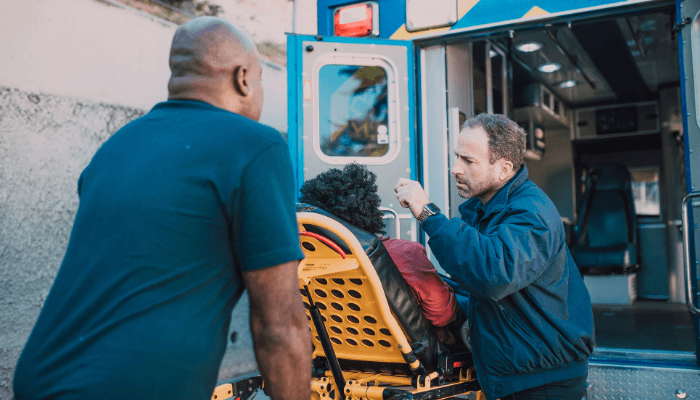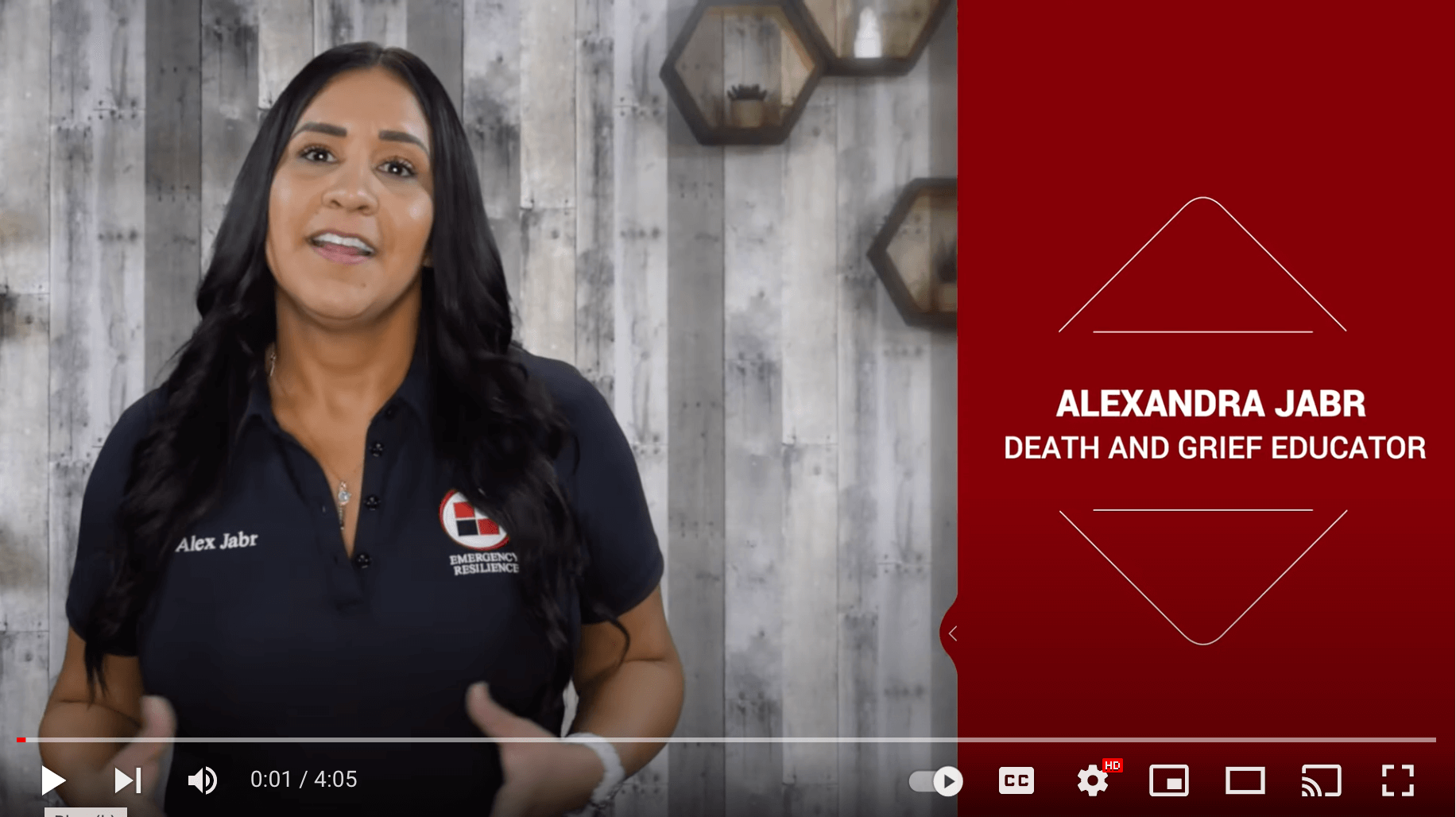Death notices can be an emotionally and psychologically complex (and okay, yes, a little depressing) topic of discussion. Despite this, proper death notification training can lessen the fear, sorrow, awkwardness, and overwhelm of death notifications for first responders.
If you’re serious about in-depth death notification training, you’ll want to enroll in my CAPCE-accredited CE course for first responders, Death Communication. At $39, it’s super affordable and available to individuals and groups.
If you want quick, actionable ways to achieve better death communication…read on! I’ll give you my 6 top tips to compassionately inform someone that their loved one has died.
Why Am I Qualified to Give Advice on Death Notifications?
I began my EMS career in 2003, serving as an EMT, paramedic, cardiac tech, EMS Coordinator, and EMS Educator. When I first began giving death notifications, I made plenty of mistakes. I learned the hard way that first responders desperately need standardized death notification training.
After nearly 15 years in the field, I returned to school to earn my Master’s Degree in Death, Grief, and Bereavement. I went on to complete my Ph.D. in Depth Psychology, deepening my understanding of the complex psychological and emotional demands of our jobs as first responders.
What is Death Communication?
Death communication is how we speak, act, and support grieving survivors —especially as it relates to emergency medicine fatalities.
I coined the phrase years ago to describe the process of conveying the news of a person’s passing to their family or loved ones. It involves the compassionate delivery of death notifications in a way that respects the dignity of the deceased.
Through death communication, we acknowledge the profound impact of loss on those left behind. We start the healing process for loved ones and make the worst day in their life a tiny bit less painful.

What Makes a “Successful” Death Notification?
Effective death communication embraces empathy, emphasizes clear and honest language, and provides as much emotional support as possible to the grieving family. But it’s also about YOUR grief and how YOU will process delivering bad news long-term because delivering awful news is not easy or comfortable.
A “successful” death notification has two parts:
1. Skills-based tactics that help you clearly convey the most important information—that their loved one has died on-scene after every possible attempt to save their life has failed.
2. What you can do, aside from conveying this essential information, to make delivering a death notification easier on yourself, the deceased’s loved ones, and the rest of the medical staff you support.
Why Is Death Notification Training Important?
Death notification training is notoriously overlooked for nurses, paramedics, firefighters, and police officers. As the founder of Emergency Resilience, I’ve spent much of my career training emergency medical professionals on best practices in delivering compassionate death notifications.
I hear it all the time: “I wish I had been trained in this sooner! Why don’t they include this in our core training?” I wondered the same thing when I first became a paramedic. I would have loved to know how to help the loved ones of my trauma victims who passed. Or at least what NOT to do to avoid making an already terrible situation worse for them.
EMS workers, despite their best intentions, may lack the specialized communication skills to deliver bad news with sensitivity and compassion. Delivering such life-changing information with grace is not something most people will ever have to do. First responders are not trained therapists, counselors, or psychologists. So why would we expect emergency medical professionals to know exactly what to say and what to do in traumatic situations with zero training?
What Are the Consequences of a Poor Death Notification?
Before we dive into how to deliver a successful death notification, it’s important to know the consequences first responders can face if a death notification is delivered poorly.
• Interruption of the Grieving Process.
The grieving process is already incredibly difficult for families, and an insensitive or poorly handled death notification can compound their trauma and lead to prolonged grief, anxiety, and even symptoms of post-traumatic stress disorder (PTSD).
Conversely, properly delivered death notifications can result in higher patient and family satisfaction levels, even in the face of a tragedy. Families who receive compassionate and well-handled notifications are more likely to be satisfied with the care provided and trust that every possible action was taken to help their loved one.
• Negative Impact on Provider Mental Health.
Loved ones aren’t the only ones impacted by death notifications. Healthcare providers, including EMS workers, who are involved in delivering death notifications often experience a significant emotional toll.
Without proper death notification training, first responders are more likely to suffer from stress, compassion fatigue, burnout, depression, anxiety, and even an increased risk of substance abuse to cope.
• Miscommunication, Confusion, and Distress.
While studying death, grief, and bereavement in graduate school, I surveyed 113 first responders about their experiences with death notifications. Of those participants, a shocking 92.9% reported that they had responded to a call where the patient met the criteria for being pronounced on scene but was transported to the hospital because of a chaotic environment, distraught family members, and discomfort with having to notify the family or leave the deceased on scene.
Without formal training, there’s a higher risk of miscommunication during death notifications. Emergency medical workers may struggle to provide clear and comprehensive information to the family. This lack of clear communication can leave family members feeling confused, upset, and even angry and aggressive. It can also potentially impede their ability to process the loss and make informed decisions regarding their loved one’s final wishes.
None of this is good—for survivors or first responders. And many of these negative outcomes can be avoided with proper death notification training.
Tips to Deliver Compassionate Death Notifications
Now that we’ve discussed why emergency medical or first responder professionals need to receive proper death notification training, I want to pass on some of the most impactful things I’ve learned in my career—both as a paramedic and a Ph.D. in Psychology.
1. Promptly Notify the Family of Your Plan.
It’s crucial to inform the family of your intentions when delivering death notifications. Let them know how long you and your crew intend to remain on scene and reassure them that your team is delivering the same level of emergency medical care that the patient would receive in a hospital.
This transparency is important to establish trust and ensure that the family feels informed and supported.
2. You Must Be Crystal Clear.
When delivering the news of a loved one’s passing, clarity is of utmost importance. It’s natural to want to soften the blow with euphemisms, but this can often create unnecessary confusion for the family. Use clear and straightforward language, even if it feels uncomfortable.
While you may be reluctant to bluntly say “Your loved one has died,” clarity in communication is an act of kindness, helping the family process the reality of the situation and begin their grieving process with a solid understanding of what has happened.
3. Silence is Golden.
There are moments in death communication when saying nothing at all is the most appropriate response. After delivering difficult news or providing essential information, your presence alone can offer comfort and support to the grieving family.
Silence allows them the space to process their emotions and thoughts without feeling rushed or pressured. It can also be a way to show respect and empathy, acknowledging the gravity of the situation.
4. Encourage Goodbyes.
If circumstances permit, allowing the family to say their goodbyes before terminating resuscitation efforts can be profoundly healing. It gives them closure and the opportunity to express their final words and emotions to their loved ones.
The chaos and shock of the situation may make it hard for them to acknowledge that their loved one is not responding to resuscitation, so it can be helpful to prepare them by verbalizing that you will be discontinuing efforts soon and it’s time to say goodbye. This can (hopefully) help them have fewer regrets and more closure. Even if they don’t fully appreciate it at the time, they will later.
5. Your Job is Not to “Fix” Their Grief.
It’s essential to recognize that your role is not to fix or alleviate the family’s grief.
I know how hard this is! We are conditioned to want to help and “fix it”. Standing back and doing nothing does NOT come naturally to a first responder. While your instinct may be to intervene and try to make things better, the most supportive action is to step back and allow the family to grieve, however that may look.
6. It’s Natural To Feel Second-hand Grief.
If you take nothing else away from this article, please remember that it’s 100% natural to feel shaken, upset, scared, sad, freaked out, and very aware of your own mortality after delivering a death notification. When you brush up against death and witness the pain and upheaval it causes others, it’s going to affect your state of mind.
Successful death notifications make this second-hand grief easier to cope with for you, too. But never be afraid to reach out for help if you feel like you need help processing complicated emotional and psychological responses to a fatality. I’ve seen far too many first responders burn out because they haven’t prioritized their mental health.
How Can You Or Your Organization Get Death Notification Training?
I’m passionate about making death notification training accessible to ALL first responders, so I offer my online CAPCE-accredited CE course, Death Communication, for only $39 per individual. I also develop custom in-person classes for groups and speak at first responder conferences nationwide.
Get in touch with me here to learn more about group subscriptions to my course, and browse my other related courses here!



